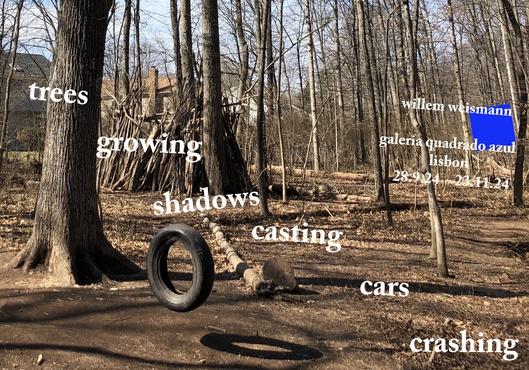Galeria Quadrado Azul is pleased to announce trees
growing shadows casting cars crashing, an exhibition by Willem Weismann,
which present a new group of paintings, in which he
examines our relation with nature and yearns a new spot for humanity’s place in
the world.
Previous exhibitions functioned more as an
archaeological accounting of what is essential and what can be discarded in
life, yet these new works look forward to a different tomorrow. Conceived and
drawn from his imagination, Weismann leans into representations of experience,
instead of relying on the mediated interface of photography, he explores how we
shape and are shaped by the ‘more-than-human world’ : a phrase coined in 1996
by cultural ecologist David Abram to signify the broad commonwealth of earthly
life, which intended to indicate that human culture was a subset within a
larger set - that the human world was necessarily sustained, surrounded, and
permeated by the more-than-human world - yet also meant to encourage a new
humility on the part of humankind.
Correspondingly, ‘plant blindness’, a term coined by
botanists educators J. H. Wandersee and E. E. Schussler in 1999, describes the
phenomenon of human’s inability to see or notice plants in one's everyday life.
It refers to our failure to recognize the role of plants on earth and our
historical belief that they are somehow inferior to animals. In Weismann’s work
there has long been an attempt to encourage ‘human blindness’; the figures have
characteristically functioned more as extras than as lead characters. They are
usually obscured or cropped, and in this exhibition they are hidden behind
trunks or leaves. Weismann’s plants are found standing side by side with
humans, and in some paintings trees are given a metaphorical agency and are
depicted saving the lives of humans from crashing cars.
Shadows also conceal figures from our scrutiny, and
echo a series of paintings produced a decade earlier, in which the artist
painted exclusively with a black oil paint made of a coal pigment. The
impressionists' dictum was that black should not be used in painting, since it
does not exist in nature. Weismann accentuates this unnaturality, and uses
black shadows to bring out the definition of shapes and reveal the constructed
quality of his compositions. By creating these disruptive gaps among the
vibrant hues on the canvas, a discombobulating effect occurs, leaving the
viewer to fill in these obscured spaces, both pictorially and interpretatively.
The images of destroyed vehicles and slashed tires,
repeated in a number of works, provoke a challenge to the viewer, and embody a
defeating realization of the apparent futility of an individual’s position to
affect any meaningful change. They provide a visual response to Andreas Malm’s How to blow up a pipeline (2021) as well as Amitav Ghosh’s The Great Derangement (2016). The former argues for
sabotage as a logical form of climate activism and critiques climate fatalism
as well as the nonviolence and pacifism in the climate activist movement, while
the latter examines our inability to grasp the scale and violence of climate
change.
Manifesting the destructive side of the creative
process, Weismann's works are a reminder that we cannot extract our existence
out of nature or simply depict nature in a vacuum by cropping out ourselves and
everything that we bring into existence. They propose a new paradigm.
This is Weismann’s third solo exhibition with the
gallery and follows after ‘Flotsam
& Jetsam’ a duo exhibition
with Hugo Canoilas in 2022.
Willem Weismann lives and works in London, other
recent exhibitions include ‘Willem
Weismann / Waldemar Zimbelmann’ at
Annarumma Gallery, Naples and group exhibitions ‘Slaap!’
at Kunsthal Kade, Amersfoort, the Netherlands, ‘Les Pays-Bas, l'autre pays des beaux-arts’, Centre d’Art Contemporain, Meymac, France and ‘The Stand Ins: Figurative Painting from the
Collection’, Zabludowicz
Collection, London.
This exhibition was made possible through the generous support of the Mondriaan Fund.



